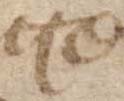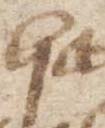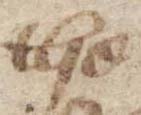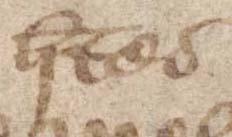|
| A |
 | Usage: estward
single compartment 'a' used throughout within the text. |  | Usage: Italia
(first 'a') a squarer version of single compartment 'a'. |
 | Usage: Afterward
double compartment 'A' used for the upper case graph. |  | Usage: Apulia |
|
| D |
 | Usage: drieth
'd's are looped and consistently shaped. |  | Usage: myddyll |
 | Usage: lond
final 'd' often has a trailing tag. |  | Usage: Danubius
upper case 'D'. The trailing ends of the graph above intrude onto the top of the letter. |
|
| G |
 | Usage: gallia
the tail of 'g' turns counter-clockwise. |  | Usage: sprygeth
'g' sometimes has a horned head. |
 | Usage: enough
the horizontal cross-bar from 'g' continues to form the head-loop of 'h'. |  | Usage: Grekes |
|
| H |
 | Usage: hath
the limb is generally a vertical line sometimes set at an oblique angle. |  | Usage: the
the head-loop of 'h' leans over to the right sometimes almost resting on the following graph. |
 | Usage: hight |  | Usage: h(er)tes
the scribe uses a straight line through the head of 'h' as an 'er' abbreviation. |
|
| R |
 | Usage: reigned
long 'r' is used more frequently than modern 'r' but both graphs are used in all positions. |  | Usage: moder
a squat modern 'r'. |
 | Usage: ster
long 'r' in final position with flourish, perhaps to represent a missing 'e'. |  | Usage: Ryue |
|
| S |
 | Usage: sides
long 's' is used in medial and final positions. It generally sports a kind of hump at the top of the stem where the scribe begins his stroke. |  | Usage: hilles called
sigma 's' used in final position. |
 | Usage: frenshmen
both 's' and 'h' appear to lean. |  | Usage: Saturnus |
|
| W |
 | Usage: well
simple form of 'w' with or without an approach stroke to the left limb. |  | Usage: Which |
 | Usage: wyne |  | Usage: wt |
|
| Y |
 | Usage: spryngeth
the tail of 'y' is generally long and frequently tangles with graphs on the line below. |  | Usage: theryn |
 | Usage: sayleth |  | Usage: shortly |


































